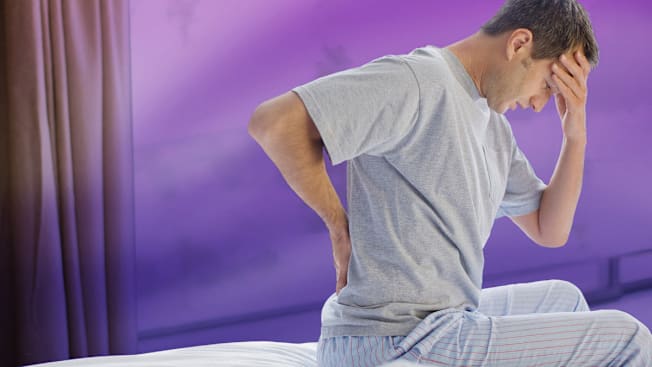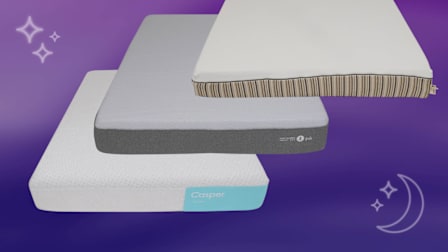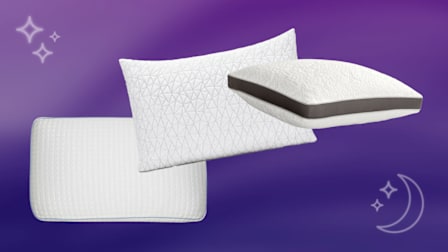Best Mattresses for Back Pain
Turn ouch and oy into ooh and aah with the right mattress—and these expert tips for all-night comfort
When you shop through retailer links on our site, we may earn affiliate commissions. 100% of the fees we collect are used to support our nonprofit mission. Learn more.

At a certain age, back pain seems to become the new normal. Moans and groans creep in between words and, gradually, we surrender to our achy fate. But what if we didn’t? What if we challenged the inevitability of back pain by taking a look at the things we can change? What if—and this may sound radical—you just need a new mattress?
If you’re living with back pain, you’re not alone. More than a third of adults said in a survey that they had experienced back pain in the previous three months, according to a report from the National Center for Health Statistics in 2021. There could be many causes for back pain. But don’t ignore one of the most obvious: a worn-out mattress.
Best Sleep Setup for Back Pain
“Sleeping on your stomach tends to worsen back pain,” says Nnaemeka Echebiri, MD, a physiatrist at the Hospital for Special Surgery in New York City. When your hips sink into the mattress, they force your lower back into a hyperexteded or overarched position. This stresses the small joints that connect the vertebrae—known as the facet joints—and can increase pain, especially for people who have underlying arthritis.
Instead, try to sleep on your back with a pillow or a bolster underneath your knees. “This can reduce pain by taking pressure off the facet joints,” Echebiri says. (Sleeping on your side could also be a good option, he says.)
A move as simple as switching the side of the bed you sleep on could ease strain, says Karen Gstalder-Dring, a physical therapist in Irvington, N.Y. “If you’ve been turning to your left for a lifetime, changing to the right could make a difference,” she says. And if you sleep with a partner, “you tend to be attracted to sleeping in a certain pattern together. Trading spots might naturally shift things and provide some ease and comfort.”
Best Mattresses for Back Pain
When you’re lying down, “the most important thing is to maintain a neutral spine,” Echebiri says. In bed, your spine should have basically the same alignment it has when you’re standing up.
To achieve that neutral alignment, with the natural curves of the spine maintained and supported (not flattened), pick a medium-firm mattress. “They tend to provide the best support without creating uncomfortable pressure points,” says Chris Winter, MD, a sleep specialist and host of the podcast Sleep Unplugged. In our mattress ratings, medium-firm mattresses tend to get a firmness score between 5 and 7.
Many in this range can offer that level of support, but foam mattresses, which may allow the body to sink in more, can make it challenging to change positions, especially if you have joint pain.
Below are the highest-scoring innerspring mattresses from our tests that we found offer medium-firm support. For more options, see the best mattresses from our tests or our comprehensive mattress ratings and buying guide.
Best Pillows for Back Sleepers
“Many people over-pillow, especially if they sleep on their back,” Gstalder-Dring says. Some of this may be due to tech habits. “We’re a society that is starting to adapt to forward-head posture because of our phones. When you’re jutting your head forward all day and you go to lie down on your back, the bed is very far away. So we use more and more pillows to support that.” But she says one right-sized pillow is usually enough to keep your neck in a healthy, neutral position. For back-sleepers, Gstalder-Dring often suggests a dense pillow on the bottom, then a very soft down pillow tucked in just under the neck, to fill the curve.
“The neck and back are very similar in that for both, neutral positioning is the key to comfort,” Echebiri says. “Typically, one pillow is enough to support the head without creating excessive head tilt or flexion.” He recommends adjustable-fill pillows, which enable you to add or remove cushioning to achieve the ideal height. (Experts say a thinner pillow—3 to 5 inches thick—is best for back sleepers.)
Here are three of CR’s top-rated adjustable pillows. Each allows you to easily add or remove fill to land on the loft that’s best for your sleep setup.
Self-Care for an Aching Back
Exercise, stress management, and a few handy tools can make a difference when it comes to back pain. Here are a few ideas:
• We’ve covered surprising ways to ease back pain—and the link between back pain and stress.
• One of our favorite heating pads is one you can wear like a king’s robe to soothe an achy upper back.
• Unsure whether yoga or tai chi are helpful (or hurtful) for your back? The research is interesting.
• In our recent investigation into the effectiveness of natural cures, we put together a list of proven remedies to help back pain and those to avoid.
• We’ve valiantly tested massage guns (a tough job, but somebody’s got to do it).
• And we’ve tapped experts for advice on becoming less stiff and more flexible, overall.
Editor’s Note: A version of this article also appeared in the March 2025 issue of Consumer Reports magazine.






























